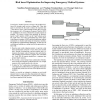Free Online Productivity Tools
i2Speak
i2Symbol
i2OCR
iTex2Img
iWeb2Print
iWeb2Shot
i2Type
iPdf2Split
iPdf2Merge
i2Bopomofo
i2Arabic
i2Style
i2Image
i2PDF
iLatex2Rtf
Sci2ools
62
Voted
AAAI
2015
2015
Risk Based Optimization for Improving Emergency Medical Systems
In emergency medical systems, arriving at the incident location a few seconds early can save a human life. Thus, this paper is motivated by the need to reduce the response time – time taken to arrive at the incident location after receiving the emergency call – of Emergency Response Vehicles, ERVs (ex: ambulances, fire rescue vehicles) for as many requests as possible. We expect to achieve this primarily by positioning the ”right” number of ERVs at the ”right” places and at the ”right” times. Given the exponentially large action space (with respect to number of ERVs and their placement) and the stochasticity in location and timing of emergency incidents, this problem is computationally challenging. To that end, our contributions building on existing data-driven approaches are three fold:
Related Content
| Added | 27 Mar 2016 |
| Updated | 27 Mar 2016 |
| Type | Journal |
| Year | 2015 |
| Where | AAAI |
| Authors | Sandhya Saisubramanian, Pradeep Varakantham, Hoong Chuin Lau |
Comments (0)

